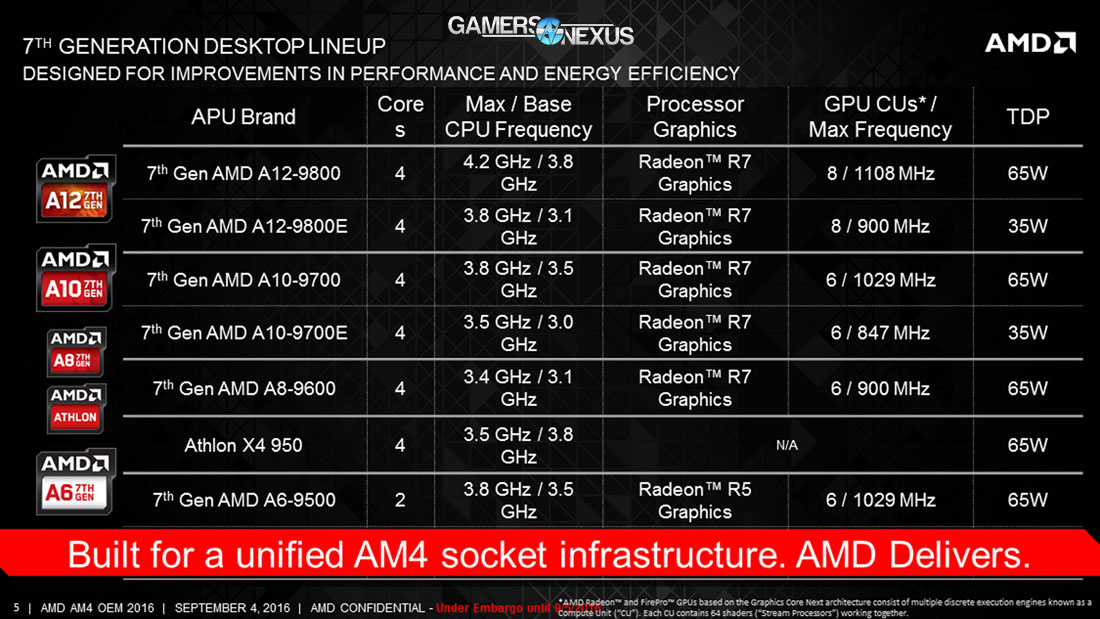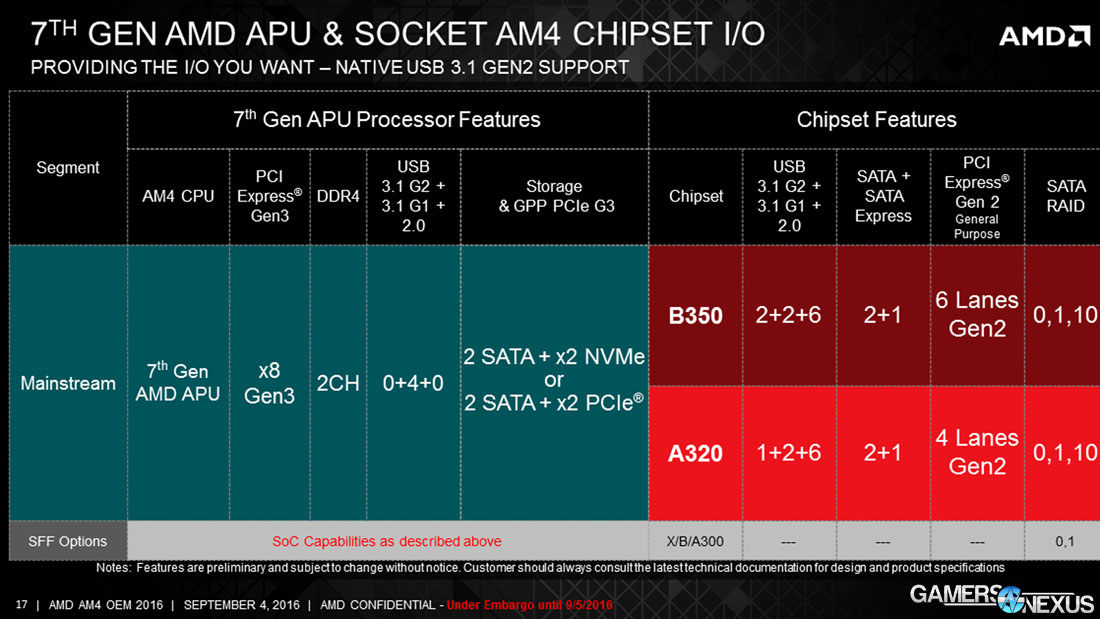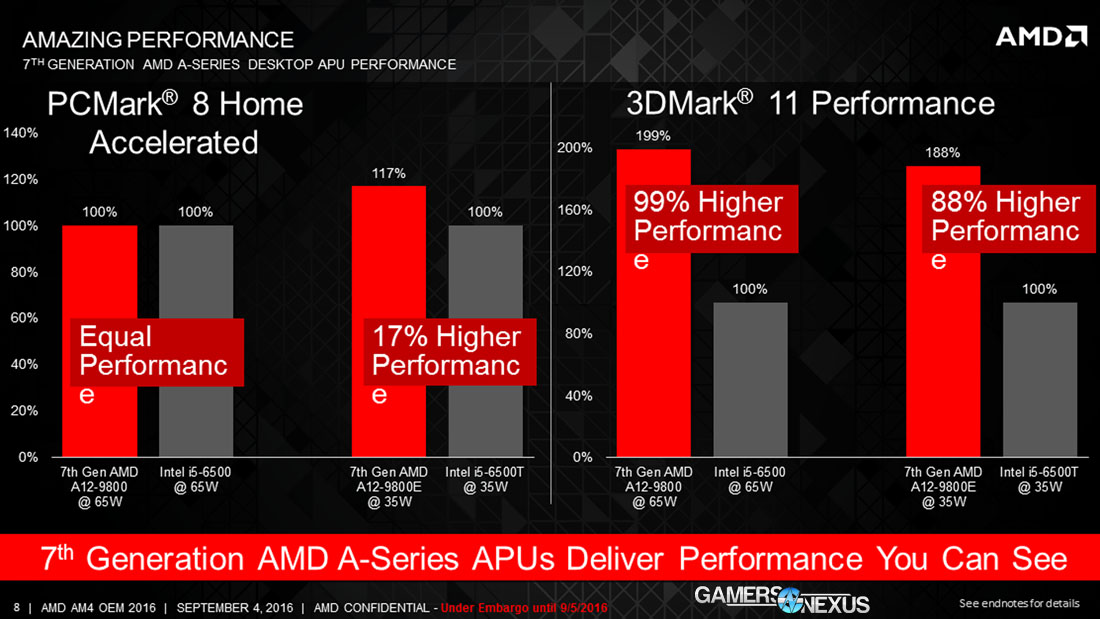The AMD Gen 7 APUs and AM4 platform have officially begun shipment in some OEM systems this weekend, primarily through OEMs at physical retail locations. AMD's launch includes entry-level and mainstream AM4 chipsets, promising the high-end Zen chipset (990FX equivalent) at a later date. AM4 platform shipment begins with the B350, A320, and X/B/A300 chipsets in accompaniment with the A12-9800 and down.
Let's run through the new Gen7 APU finalized specs first, then talk AM4 chipset specs. Note that the new AM4 motherboards are making major moves to unify the FM and AM platforms under AMD's banner, so Zen's FX line equivalent and the Gen7 APUs will both function on the same motherboard. The below table (following the embedded video) provides the specs for the A12-9800, X4 950, and other relevant chips:
AMD A12-9800, X4 950, A10-9700, A6-9500 Specs
The Gen 7 high-end APU is the A12-9800, which runs 4 of the new Excavator x86 cores at a 3.8GHz base clock / 4.2GHz boost. All the new noteworthy APUs use R7 graphics for the IGP, with the A12-9800's 8 GPU CUs clocked at 1108MHz. TDP is 65W for all chips except the *E suffixed chips, which are 35W and significantly lower clock-rates.
The A10-9700 loses 0.3GHz off the base clock and 0.5GHz off the boost clock from the A12-9800, also reducing the GPU to 6 CUs from 8 on the 9800. The A6-9600 is comparable, just with still-slower clock-rates.
We think the X4 950 will be among the most interesting options, since users will be able to use a low-end CPU with the IGP disabled for cheap, then couple that with a dedicated GPU for min-maxed performance.
The A6-9500 APU is only a two-core processor, and isn't really worth considering for most games at this point. This is a low-end consumer part.
Note that the new Excavator CPUs and AM4 low-end platforms will support a maximum of 2400MHz for DDR4 speeds.
AM4 B350 & A320 Chipset Specs & AMD Internal A12-9800 Benchmarks
As for the chipset news, AM4's initial shipment will be for the B350, A320, and X/B/A300 chipsets. AM4 will unify the FM2+ and AM3+ platforms into a new, single chipset, which will now support PCIe Gen3 and USB3.1 Gen2 natively. This is a big move for AMD, and will ensure that their APUs and CPUs can live easily in a single motherboard. That said, you'll want to check for compatibility between CPUs and boards if planning to upgrade.
The absolute basics below:
Mainstream: AMD B350. Parallels 970 and A78. B350 has a 5.8W TDP, as opposed to 7.8W TDP of A78 and 19.6W TDP of 970.
Low-end: AMD A320. Parallels 760G and A68G – not something we'd generally recommend for our audience and more targeted at low-end consumer/office.
Small Form Factor: AMD X/B/A300.
The Gen7 APUs support dual-channel DDR4, a maximum of 4x USB3.1 Gen2, 2x SATA III, and 2x NVMe lanes, or alternatively 2x SATA III ports and 2x PCIe lanes for M.2 usage.
The B350 chipset adds 2x USB3.1 Gen2, 2x USB3.1 Gen1, and 6x USB2.0. 2x SATA III lanes are present, with 1x SATA-E that can be peeled off for 2x SATA III instead. 6X PCIe Gen2 lanes are available for M.2 and general purposes devices, and SATA RAID is supported at 0, 1, and 10.
The AM4 A320 chipset will lose 1x USB3.1 Gen2 channel and lose 2x PCIe Gen2 lanes, and the X/B/A300 chipsets will lose RAID 10 support, among other features that we're not fully clear on.
AMD is claiming equal performance in PC Mark 8 Home Accelerated, watt-for-watt, when using an A12-9800 at 65W vs. an Intel i5-6500 65W CPU.
The company is also claiming 17% higher performance against an i5-6500T, watt-for-watt, when comparing the low TDP chips (E vs. T).
In 3DMark 11, which is ancient at this point, AMD is claiming nearly 2x performance gains on the IGP versus their selected Intel CPUs. AMD's typically been ahead in IGP performance, partially due to greater die allocation for graphics.
Note: This isn't a 100% CPU-to-CPU comparison and also compares other elements. AMD used faster memory on their own test systems: the Endnotes show that AMD is running DDR4-2400, while Intel is running DDR4-2133 – so some of this is chalked-up to DRAM speed differences. Although Intel cannot support DDR4-2400, the comparison is at least partly showing the DRAM impact. Had AMD used the same DDR4-2133 configuration on their platform, we'd better understand CPU-to-CPU deltas – but faster DRAM support is still a valid benchmark.
As we understand it, you would not want to pair these early AM4 chipsets with Zen CPUs as they may drag down performance for the faster 8-core chips. We also don't yet know which boards will support the Zen CPUs, so we'd advise on waiting for now, if Zen is in the build plans.
Editorial: Steve "Lelldorianx" Burke
Video: Keegan "HornetSting" Gallick


